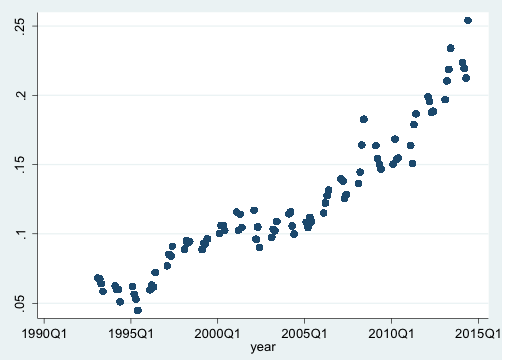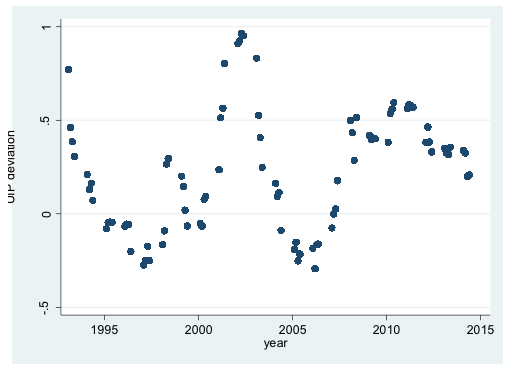It has been widely accepted that banks’ credit supply to the real economy is affected by monetary policy. The well-established ‘bank lending channel’ of monetary policy states that, once monetary policy is tightened, banks face a higher funding cost in the domestic money market so they have to cut back their lending; with reduced credit available, the real economy starts to cool down. In their seminal paper, Kashyap and Stein (2000) presented solid micro-level evidence of such a channel using US data. Later, most of the bank-level studies on the lending channel have been focused on how the impact of monetary policy on bank lending varies across banks.1
However, US banks’ lending supply, overall, is largely dictated by domestic monetary policy due to the size of the US money market and the dominance of the US dollar in the international money market – US banks’ liabilities are denominated in US dollars. In other open economies, things may be quite different. Recently, attention has been focused on emerging economies where, for various reasons, banks borrow heavily in foreign currencies and issue loans mostly denominated in foreign currencies, so that bank lending reacts more to foreign than domestic monetary policies.2 However, less attention has been paid so far to small, open, advanced economies in which banks obtain funding from abroad but issue loans mostly in domestic currencies. If bank lending there is largely denominated by domestic currency, does domestic monetary policy have a better grip on bank lending?
The case of Norwegian banks
Take Norway as an example. Figure 1 shows the share of foreign currency liabilities of Norwegian banks for 1994-2015. It has been rising steadily; as of today, the share is above 30%. Similar numbers are also observed in many other open economies, such as the euro area. If banks rely on funding in foreign currencies whose funding costs are not directly affected by domestic monetary policy, will the transmission of domestic monetary policy through the bank lending channel still be as effective as in a closed economy? For example, suppose a central bank wants to contain a domestic credit boom by raising the monetary policy rate, will banks then go for cheaper funding sources abroad and avoid the adverse impact on their lending?
We investigate this question by looking at the quarterly balance sheet data for all Norwegian banks between 1994 and 2015 (Cao and Dinger 2018).3 First, we apply the standard empirical model established by Kashyap and Stein (2000) and see whether tightening (loosening) monetary policy generates the desired contractionary (expansionary) impact on banks’ lending supply, as theory predicts. However, our results show that, overall, the standard theory of the bank lending channel is not supported by the data.
The result is less surprising once the sources of banks’ funding are taken into account. For a small open economy, domestic monetary policy only affects the funding costs in the domestic money market (with domestic currency), but not the ones they face in the international money market (with foreign currencies); that is, there’s an interest rate differential between them. It is noteworthy that such an interest rate differential alone is not equivalent to banks’ funding costs differential – should financial markets be perfect, arbitrage would immediately increase the demand for the high-yield currency, leading to appreciation of that currency, and making the funding cost between the domestic money market (paying the domestic interest rate) and the international money market (paying the foreign interest rate, plus currency exchange costs) equivalent; this is the so-called ‘interest rate parity’.
Figure 1 Share of foreign currency liabilities of Norwegian banks, 1994–2015
However, in reality the interest rate parity may not hold – there is a deviation between the actual Norwegian krone/US dollar exchange rate and the exchange rate predicted by interest rate parity, as is shown in Figure 2. This deviation was relatively small in the 1990s, becoming wider over time. Most of the time the deviation is positive, meaning that the krone appreciates more than theory predicts. The persistence of this positive deviation implies that banks can build expectations about this dynamic of exchange rates and have strong incentives to seek funding in foreign currencies, as an appreciating krone – after controlling for interest rate differentials – implies that they repay less in foreign currencies.4
There are many reasons why actual exchange rates deviate from theoretical predictions. An important one is risk premium – for example, during turbulence, foreign investors may regard Norway as a safe haven and increase their demand for Norwegian financial assets, even with a premium, so that the krone appreciates more than what is predicted by theory. Krone exchange rates are also affected by global oil price dynamics that are not related to the Norwegian monetary policy rate. This contributes further to the deviations of exchange rates from theoretical predictions.
Figure 2 Deviations (in percentage) from uncovered interest rate parity, Norway 1994–2015
A central bank can eliminate the deviation by active intervention in the foreign exchange market, as Norway did before 2001. After 2001, Norges Bank shifted its mandate to price stability and completely stopped intervention in the exchange market. The impacts of this regime change are clearly seen – the exchange rate deviation becomes much wider and more likely to be positive after 2000 (Figure 2), and with cheaper funding from abroad banks’ foreign currency funding started to take off too (Figure 1).
If the international money market has become an important funding source for Norwegian banks, including only domestic monetary policy in the standard ‘lending channel’ empirical model may present an incomplete picture. Indeed, the standard model with only domestic variables estimated for Norway in the pre-2001 period illustrates that bank lending reacted in opposition to the monetary policy rate, just as the theory predicts. But this same model fails to find such evidence after 2001, when foreign funding gained relevance. To control for the rising role of international factors, we therefore re-estimate this standard model including the deviations of the krone exchange rate from its interest parity predictions as an indicator of the relative costs of foreign versus domestic funding sources. After that, both the monetary policy rate and interest rate parity deviation become significant with the correct signs, implying that bank lending is actually driven by both domestic and international factors.
Additionally, we also find that banks actively shift their funding between the domestic and international money markets, depending on which offers more favourable conditions. When domestic monetary policy is loosening, the conventional bank lending channel works and banks expand their lending by tapping the cheaper domestic money market more; however, when domestic monetary policy is contractionary, the channel stops working and banks don’t necessarily cut back lending, implying that they exploit more international funding to cushion domestic tightening.
One may think that the impact of global funding only exists for a handful of the largest banks (out of a total of 120 or more banks in Norway) that have active access to the international money market. However, given that those ‘international’ banks are also providing liquidity to the ‘non-international’ banks in the domestic interbank market, the latter receive higher krone-denominated interbank lending from the former when international funding is more favourable. In other words, the global funding channel passes through to banks with no access to the international money market!
Concluding remarks
The banking sector is a key component in the transmission of monetary policy. A change in monetary policy immediately affects banks’ credit supply to firms and households, which is an important anchor of future real activities. Therefore, how effective monetary policy is in dictating banking activities is one of the keys to understanding how efficient monetary policy is in tuning the real economy. Such efficiency, as our research shows, may be eroded by international financial flows in a small open economy. For central banks and financial regulatory agencies in small open economies, this implies several challenges.
The first is whether central banks need a new paradigm for monetary policy analysis. Our results indicate that the foreign funding channel should be incorporated into the analysis of the effectiveness of monetary policy. The rising availability of foreign funding may make banks’ lending rates – or, the funding costs of firms and households – react less to policy rates, and make the real economy react less to policy rates. There has so far been little relevant research establishing this relationship empirically.
The second refers to the design of macroprudential policies. As we show, banks take advantage of cheaper domestic funding and expand lending during monetary loosening but turn to international funding to avoid lending contraction during monetary policy tightening. Therefore, the ‘lean-against-the-wind’ type of monetary policy that aims to contain credit cycles may be undermined. Within current macroprudential regulations, such as Basel III, there has been little distinction between domestic and foreign funding sources. Therefore, banks may still use foreign funding to arbitrage against domestic monetary policy that attempts to put the brakes on credit booms.
Third, how much should global banking be regulated? Needless to say, rising globalisation in banking and foreign currency funding increase the likelihood of financial contagion and the vulnerability of banks to foreign shocks. But before arguing for full capital controls, one has to keep in mind that the foreign funding channel also improves the diversity of banks’ funding sources, facilitating international risk-sharing and cushioning the impact of domestic shocks. After all, any future global framework of banking regulation needs to balance these benefits and costs.
Authors’ note: The views expressed in this column are those of the authors and do not necessarily reflect the views of their affiliated institutions.
References
Baskaya, Y S, J di Giovanni, S Kalemli-Özcan and M F Ulu (2017), “International spill-overs and local credit cycles”, NBER, Working Paper 23149.
Bräuning, F and V Ivashina (2017), “Monetary policy and global banking”, NBER, Working Paper 23316.
Bruno, V and H S Shin (2015a), “Capital flows and the risk-taking channel of monetary policy”, Journal of Monetary Economics 71: 119–132.
Bruno, V and H S Shin (2015b), “Cross-border banking and global liquidity”, Review of Economic Studies 82: 535–564.
Cao, J and V Dinger (2018), “Financial globalization and bank lending: The limits of domestic monetary policy?” Norges Bank, Working Paper 4/2018.
Cetorelli, N and L S Goldberg (2012), “Banking globalization and monetary transmission”, Journal of Finance 67: 1811–1843.
Hofmann, B, I Shim and H S Shin (2016), “Sovereign yields and the risk-taking channel of currency appreciation”, BIS, Working Papers No 538.
Kashyap, A K and J C Stein (2000), “What do a million observations on banks say about the transmission of monetary policy?” American Economic Review 90: 407–428.
Morais, B, J-L Peydró and C Ruiz (forthcoming), “The international bank lending channel of monetary policy rates and QE: Credit supply, reach-for-yield, and real effects”, Journal of Finance.
Rey, H (2015), “Dilemma not trilemma: The global financial cycle and monetary policy independence”, NBER, working paper 21162.
Endnotes
[1] Campello (2002) finds that the internal capital market within a financial conglomerate ensures stable funding conditions for affiliated banks, so that their lending supply is less affected by monetary tightening. Cetorelli and Goldberg (2012) show that US global banks raise funding by reallocating claims between headquarters and foreign subsidiaries, and such an internal capital market makes them better insulated from a contraction in domestic monetary policy.
[2] Morais et al.(forthcoming) shows quantitative easing in the US affects Mexican bank lending through foreign banks; Baskaya et al. (2017) unveils how Turkish bank lending is driven by US monetary policy. Based on country-level data, Bruno and Shin (2015a) show how US monetary policy spills over to cross-border bank capital flows through fluctuations in banks’ risk-taking behaviour, amplifying the leverage cycle in the foreign banking sector. On the aggregate level, Rey (2015) finds that the monetary policy of the US affects the leverage of global banks, which leads to co-movements of global asset prices, cross-border capital flows, and credit growth in the international financial system.
[3]Including commercial banks, savings banks, subsidiaries of foreign banks, branches of foreign banks, and bank-affiliated mortgage companies.
[4]Such mechanism has been proposed by Bruno and Shin (2015b).





